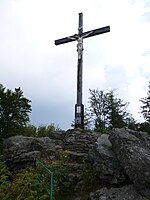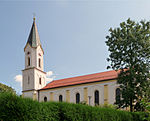Kreuzfelsen

The Kreuzfelsen is a 999 m (3,278 ft) high rock outcrop, that forms the western cornerstone of the Kaitersberg mountain ridge in the Bavarian Forest in southern Germany. From the giant cross on its summit the view sweeps down into the Zeller Valley and over to the town of Bad Kötzting and also far over the western part of the Bavarian Forest. Below the Kreuzfelsen is "Highwayman Heigl's Cave" (Räuber-Heigl's-Höhle), the hideout of a 19th-century robber. Numerous trails lead up to the summit cross, the most well-trodden being the E6 European long distance path which runs from Kötzting past the nearby Kötztinger Hütte cafe and the Riedlstein to the Großer Arber. On the Kreuzfelsen there is an extensive range of worthwhile sport climbing routes, that are well-secured and can be negotiated using top roping.
Excerpt from the Wikipedia article Kreuzfelsen (License: CC BY-SA 3.0, Authors, Images).Kreuzfelsen
Hudlacher Straße,
Geographical coordinates (GPS) Address Nearby Places Show on map
Geographical coordinates (GPS)
| Latitude | Longitude |
|---|---|
| N 49.176388888889 ° | E 12.922777777778 ° |
Address
Hudlacher Straße
93480
Bavaria, Germany
Open on Google Maps









